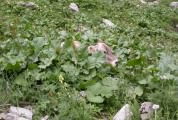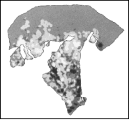 |
|
|
|
|
|
|
A high intensity of cattle grazing has a pronounced influence on nutrient turnover and nutrient availability in a pasture. The amount of plant litter is reduced by grazing and the quality of the litter is affected due to changes in the vegetation. Litter of most palatable plants favoured by grazing and pasture management decomposes much faster than litter of dwarf shrubs and less palatable graminoids like Nardus stricta. As a result of both low use by animals and slow decomposition the biomass of unpalatable species is often largely composed of dead material. Thus, grazing tends to reduce the accumulation of litter and soil organic matter and enhance nutrient turnover. |
|
Furthermore, cattle grazing leads to a large spatial redistribution of nutrients within alpine pastures. On level ground, cattle drop their dung and urine randomly. On steep terrain, however, they tend to use the flatter areas for resting and ruminating, and these receive disproportionately large amounts of the nutrients. Soil nutrients can become highly concentrated and a characteristic flora of a few nitrophilous species develops. |
1 - Lägerflur (128K) |
|
In the long run, this redistribution will lead to depletion of nutrients over wide areas of the pasture and to nutrient enrichment in a few areas characterised by Lägerflur. Where dung accumulates, the build up of nutrients in the soil may be well in excess of that required for plant growth. From these sites, nutrients may be leached and lead to the eutrophication of surface water. Alpine pastoralists try to counteract this phenomenon by rotational grazing and by redistribution of dung and slurry from farm buildings. Yet, patches of Lägerflur are a characteristic of nearly all alpine pastures, and are found especially in the vicinity of alpine huts. |
2 - P redistribution (59K) |
29 August 2011 |
||
| |
||

